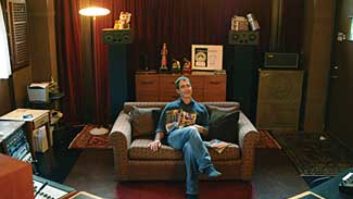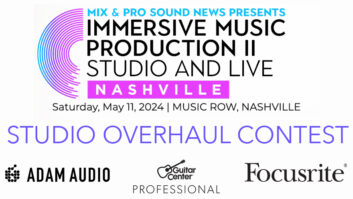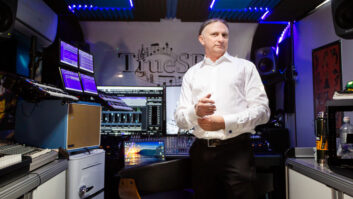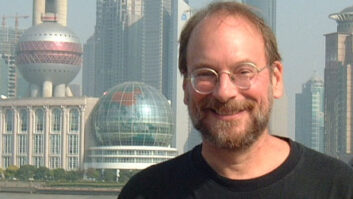Few bands seem more ubiquitous than Black Eyed Peas these days. Turn on the radio or MTV–they’re on. Read the liner notes to that hip R&B album you bought–they produced a few tracks. Pick up the newspaper–they’re in the cell phone ads. This band is everywhere, and as if to underline the fact, they’re currently on the road, too, traversing the country for eight weeks before heading off to Europe, Australia, Asia, Israel, Istanbul and Russia this summer. Whew, talk about world Peas…
Providing audio for the U.S. jaunt is Los Angeles-based Schubert Systems, and keeping the Peas train on the tracks are FOH engineer David Haines and monitor maven Tony Cooper. Haines has been with the band since the beginning, and while that might be presumed to be no big deal, given the act’s seemingly overnight success, it is, in fact, a longtime relationship–he recorded the Peas’ first demos in 1996 while in college, did their first album after they got signed the following year and hit the road to mix their first tour in 1998.
Much like the act’s career, the live-sound world has changed dramatically in the eight years since then. These days, Haines is mixing the group on a Digidesign Venue D-Show console, and has been behind that digital desk for more than a year now. “It was so new at the time when we got it that I didn’t know what to expect, but it surpassed my expectations of what I thought it would be,” he said. “It lets you use Pro Tools plug-ins, so I like using a lot of their plug-ins and effects that you use in a studio.”
Among Haines’ plug-in choices for the desk are Echo Farm delays, Focusrite compressors and Aphex aural exciters. “No serious rocket science or studio magic just yet,” he explained. “I’m trying to keep it simple and not crowd the mix with too many bells and whistles. It’s one of the quickest desks to get around; a lot of this job’s on the fly, and you make decisions really fast, so it works out. There are a lot of digital consoles that people wanted me to use in the past, and I’ve been hesitant to, because of the speed you need to get around the desk with this band, but this console lets me do that just fine.”
With a bass-heavy, beat-driven sound like the Peas’, the choice of PA is obviously imperative and, in their case, the pick was a Lab.gruppen- and QSC-powered JBL VerTec rig, supplemented by custom subs from Schubert Systems. “They tune differently than the JBL/VerTec subs that normally come with it,” said Haines. “I like the tone that we get with those. It can be a bit harsh, but you just have to know how to tune it so the sound doesn’t take your ears off. I like the flexibility that you get with them.”
The venues on the tour are all over the map; playing for 5,000 at the Theatre at Madison Square Garden in New York, the band then entertained 19,000 in Maryland the next night. The size of the PA varies from night to night, then, and so does the house mix, Haines revealed, “If there are a lot of teenage girls or young kids, I’ll try to be a little cautious with the volume and save the real thunder for the end. The older, crazier or more drunk the crowd is, the louder I’ll mix the show. I’ll always try to mix it so that you can really feel the music, but not so that you’re ears are ringing the next day. I try to mix around 105 dB and maybe push it to 110 at the end of the show. We had a few shows this past week where we couldn’t get loud at all–one show in Atlanta had a 95 dB limit, and in North Carolina, there was a 92 dB limit. At soundcheck, we were hitting 95 off the stage, without my PA or monitors on. It’s tricky to juggle those factors, but I try to be careful, and I’m proud of the fact that I have management telling me to turn it up, rather than people yelling at me to get the volume down.”
Over at stageside, Tony Cooper, monitor engineer and head of the tour’s audio department, is keeping things pumping for the band via a half-dozen sets of Sennheiser G2 ew800 personal monitors with Future Sonics ear buds, new additions to the BEP audio arsenal. “The reasons for switching to Sennheiser are because they are phenomenally easy to use, and the level of service that we get is great.” Backing up the personal monitors are six wedges and side fills.
“We decided to use the combination,” said Cooper, “because, as a friend of mine who’s a rapper in Cypress Hill put it, ‘In-ears sound great but it’s like playing for a picture of the audience.’ That’s an interesting thing to think about because it detaches some people. A lot of the musicians that are coming up now start with in-ears earlier and it becomes very comfortable, whereas people [who ‘ve] done a lot of club shows, they don’t like it because that energy that they are accustomed to isn’t there. So for us, using wedges and ears kind of fills the energy onstage for the musicians.”
All the various monitors are fed via a Yamaha PM5D at stageside, tackling 50 input channels. As for the mixes, Cooper finds himself emphasizing vocals on top of full mixes for the MCs, except for the head Pea, Will I. Am, who only gets himself, letting the aforementioned wedges do the rest. “It is kind of interesting,” admitted Cooper, “but that’s all he really needs, so he’s the easiest. As far as the rest of the band is concerned, it’s really a hip-hop feel onstage with a very heavy low end. The MCs and the band are really driven by the drummer and the beat, so it’s heavy on the kick and on the bass.”
Effects are used in moderation on the mixes, with plate reverbs on the drums and horns, a short reverb on vocals and a delay on certain songs for female vocalist, Fergie. Those vocals are captured via Sennheiser SKM935 G2 wireless mics with regular dynamic capsules. “I was a little skeptical at first,” admitted Cooper, “but I’ve grown to like them. They sound great for what’s going on here as far as our feel is concerned.”
Of course, mixing a groove-oriented act is all about the feel, but how FOH and monitor engineers approach attaining that can vary wildly, as Cooper and Haines are the first to admit. “The Zen of being a monitor guy and of being a front-of-house guy are very different,” said Cooper. “The FOH guy gets a lot of instant gratification in a sense that he’s mixing the show for the audience, and has a bit more artistic freedom in a sense. As a monitor guy, you are not really mixing for yourself; you’re mixing for 12 people onstage. For me, the joy in being a monitor mixer is watching the band that I’m working for have a really great show; I would think that at least some of that is due to what we’re doing.”
Back out at the FOH position, Haines has a slightly different view: “Even if Tony didn’t have so many people around him with all different needs, I think the work he’s doing is more complicated. But then a lot of people argue the opposite because a lot more people are listening to and scrutinizing what I’m doing, so it goes both ways. I just like the peace in my world so that I have more headspace in order to focus on what I’m doing. And I stay as far away from monitors as I can.”
Schubert Systems
www.schubertsystems.com
Sennheiser
www.sennheiserusa.com
JBL
www.jblpro.com
Vital Stats
FOH Engineer: David Haines Monitor Engineer: Tony Cooper Stage Tech: Robert Windel Crew Chief/System Engineer Dustin Delker Asst. System Engineer: Tim Johnson FOH Console: Digidesign Venue D-Show Monitor Console: Yamaha PM5D House Speakers: JBL VerTec Monitor Speakers: Schubert proprietary House Amplifiers: Lab.gruppen; QSC Monitor Amplifiers: QSC PL 236A FOH Equipment: Lake Contour; Plug-Ins:
Echo Farm; Focusrite; Aphex aural exciters
Monitors Equipment: Yamaha PM5D internal DSP Microphones: Sennheiser SKM935 wireless, E 901, 902, 905, 904, 906, 614; Neumann KM184, TLM103







